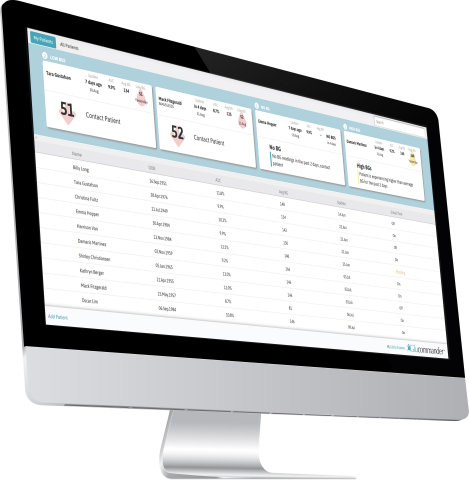WALTHAM, Mass.--(BUSINESS WIRE)--The United States Patent and Trademark Office has awarded Glytec two more patent allowances acknowledging the unique characteristics of its disruptive innovations. The allowances, which comprise a total of 52 claims, describe interactions between Glytec’s solution for insulin titration and multiple current and future-state connected diabetes technologies and health information systems, including devices, apps and other form factors for blood glucose measurement, insulin delivery and patient communication.
The two new patent allowances depict: [highly abridged and consolidated]
- A dosing controller comprising data processing hardware in communication with memory hardware, the dosing controller configured to: (1) receive sequential scheduled blood glucose time intervals for a patient from any of: a healthcare provider computing device, a remote computing device during a batch download, a glucose meter upon the measuring of blood glucose, a meter manufacturer’s computing device during a batch download, or a patient device; (2) obtain data from a glucose meter for the patient, including blood glucose measurements, time periods of such measurements and carbohydrate-to-insulin ratios; (3) determine a next recommended carbohydrate-to-insulin ratio for each scheduled blood glucose time interval based on the representative aggregate blood glucose measurement associated with the scheduled blood glucose time interval that occurs immediately after the selected time interval; (4) obtain a number of carbohydrates consumed by the patient during the selected time interval; (5) determine a recommended meal bolus based on the next recommended carbohydrate-to-insulin ratio and the number of carbohydrates consumed by the patient during the selected time interval; and (6) transmit the recommended meal bolus to an administration device configured to automatically dial in and administer the number of units of insulin for the recommended meal bolus and/or transmit the recommended meal bolus to a portable device configured to display the next recommended meal bolus.
- A glycemic control system comprising data processing hardware in communication with memory hardware, a blood glucose meter that measures a patient’s blood glucose, a user device that receives data from the blood glucose meter and displays a user interface on a screen, and a computing device associated with an authorized medical professional, the data processing hardware configured to: (1) receive a current blood glucose measurement for a patient, the time period of such measurement and, possibly, a patient input to the user device indicating a number of carbohydrates consumed; (2) determine whether the time period is pre-meal and whether the meal type is breakfast, lunch, dinner or snack; and if it is breakfast: (3) obtain a previous basal dose of insulin administered by the patient, a previous mid-sleep blood glucose measurement of the patient and a previous breakfast blood glucose measurement; (4) determine an adjustment factor based on one of the previous mid-sleep blood glucose measurements or the previous breakfast blood glucose measurement; (5) multiply the previous basal insulin dose times the adjustment factor to determine a new basal insulin dose; (6) transmit the new basal insulin dose to the user device, causing the user interface to display the new basal insulin dose, potentially during the time period of the current blood glucose measurement; and thereafter, (7) receive a patient input to the user device indicating a number of units of insulin administered with the new basal insulin dose and with any recommended meal bolus. Additionally, the data processing hardware is configured to: (8) obtain a medical professional input to the memory hardware indicating a hypoglycemia blood glucose limit for the patient; (9) determine whether the current blood glucose measurement is less than the hypoglycemia blood glucose limit; and if yes, (10) transmit an out-of-range blood glucose alert from the data processing hardware to the medical professional computing device; and (11) receive hypoglycemia patient instructions from the medical professional computing device and transmit them to the user device, causing the user interface to display the instructions. Furthermore, the data processing hardware is configured to: (12) obtain a medical professional input to the memory hardware indicating an insulin sensitivity factor and target blood glucose range for the patient; (13) determine whether the current blood glucose measurement exceeds the midpoint of the target blood glucose range; and if yes, (14) determine a correction insulin dose based on a function of the current blood glucose measurement, the mid-point of the target blood glucose range and the insulin sensitivity factor; and (15) transmit the correction insulin dose to the user device, causing the user interface to display the correction dose.
“Our mission is to help fix the insulin management problem plaguing payors, providers and most importantly, the tens of millions of people with diabetes. It’s the biggest opportunity to impact outcomes in diabetes care right now,” says Glytec’s Senior Vice President of R&D, Robby Booth. “These latest patents are further testimony to our unmatched record of innovation and leadership in addressing the risks and complications of insulin therapy that result in overwhelming personal and societal costs.”
About Glytec
Glytec is the pioneer of personalized digital therapeutics, enabling best practices for inpatient and outpatient insulin management. The company’s patented and FDA-cleared software-as-a-medical-device solutions improve the safety and health of people with diabetes and make insulin a more effective medication option for the millions unable to achieve their treatment goals. Glytec combines evidence-based decision support technologies with expert clinical services to optimize insulin therapies in the hospital and at home, leading to reductions in hypoglycemia and other complications as well as avoidable ED visits, hospitalizations, readmissions and drug waste. For more information visit www.glytecsystems.com.




